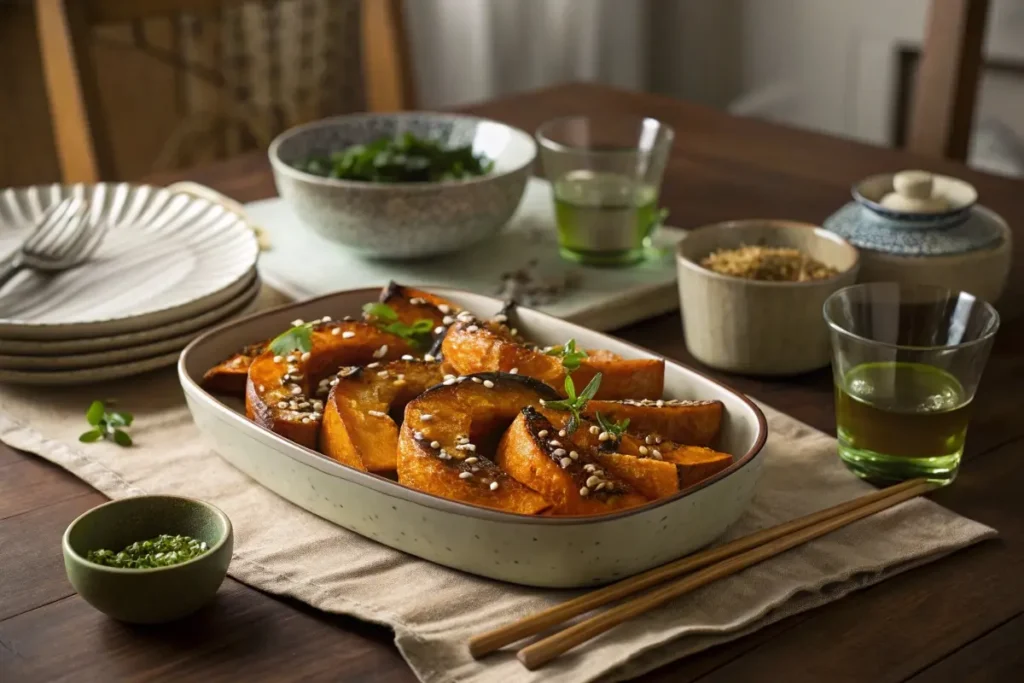If you’ve ever encountered a deep green squash with bright orange flesh in the produce aisle, chances are you’ve just discovered japanese pumpkin, also known as kabocha. This sweet, hearty squash is widely used in Japanese cuisine, prized for its rich flavor and velvety texture. Within your first bite, you’ll notice kabocha squash boasts a pleasant sweetness that pairs beautifully with savory seasonings, making it a staple in dishes like soups, stir-fries, and tempura. Whether you’re curious about roasted kabocha squash, wanting to master a kabocha squash recipe, or simply intrigued by the difference between pumpkin and Japanese pumpkin, this article will guide you through it all.
For more Japanese cooking inspiration, feel free to explore our Japanese Vegan Recipes, which offers plant-based ways to incorporate traditional flavors. Let’s dive in and discover everything you need to know to create your own japanese pumpkin recipe at home!
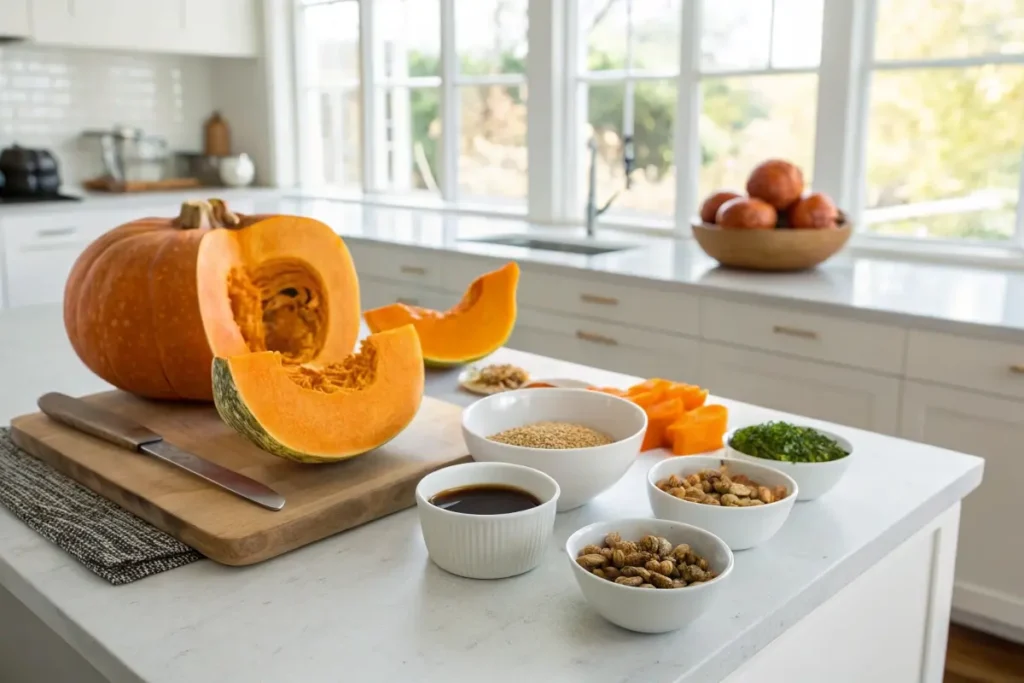
What Makes Japanese Pumpkin Unique?
Before jumping into recipes, it’s important to understand what is the difference between pumpkin and Japanese pumpkin? Unlike the large, round Halloween pumpkin we often see in Western grocery stores, Japanese pumpkin—or kabocha—is a smaller, denser variety. This compact shape houses a sweet, nutty flesh that many chefs liken to a cross between a sweet potato and a standard pumpkin.
Flavor and Texture
- Sweetness: Kabocha’s inherent sweetness is more pronounced than typical Western pumpkins.
- Consistency: The flesh is dense and velvety, making it perfect for soups, stews, or roasted sides.
- Skin: Kabocha’s rind is dark green and can appear bumpy. The surprising part? Do you eat the skin of kabocha squash? Absolutely, yes! It’s generally edible once cooked, providing extra nutrients and a pleasant texture.
Nutritional Profile
Many wonder, Is kabocha healthier than pumpkin? Kabocha is loaded with vitamins A, C, and E, plus dietary fiber and beta-carotene. Its lower carbohydrate content and higher nutrient density compare favorably to some other pumpkin varieties. While both standard pumpkins and kabocha can be healthy choices, kabocha’s denser nutrient profile makes it a top pick for health-focused individuals.
Culinary Versatility
Kabocha’s mild sweetness and firm texture lend themselves to various culinary techniques:
- Steaming and Boiling: Ideal for soups and curries to retain moisture and soften the flesh.
- Roasting: Brings out deeper caramelized notes, making roasted kabocha squash a popular side dish.
- Stir-Frying: Integrates well with savory sauces like soy sauce, mirin, or miso.
In many Japanese households, kabocha no nimono (kabocha simmered in dashi and soy sauce) is a beloved classic. The slices absorb the broth, becoming tender and flavorful.
Pairing Japanese Pumpkin with Other Ingredients
Because of its sweet undertones, kabocha pairs exceptionally well with savory and salty elements:
- Soy Sauce: Balances the sweetness with salty umami.
- Ginger and Garlic: Add a zingy, aromatic depth.
- Mirin or Sake: Amplifies natural sweetness while contributing mild acidity.
If you’re seeking other vegetables that complement Japanese flavors, check out our Vegetables Japanese Recipe. You’ll find cooking methods and seasoning tips that blend beautifully with kabocha.
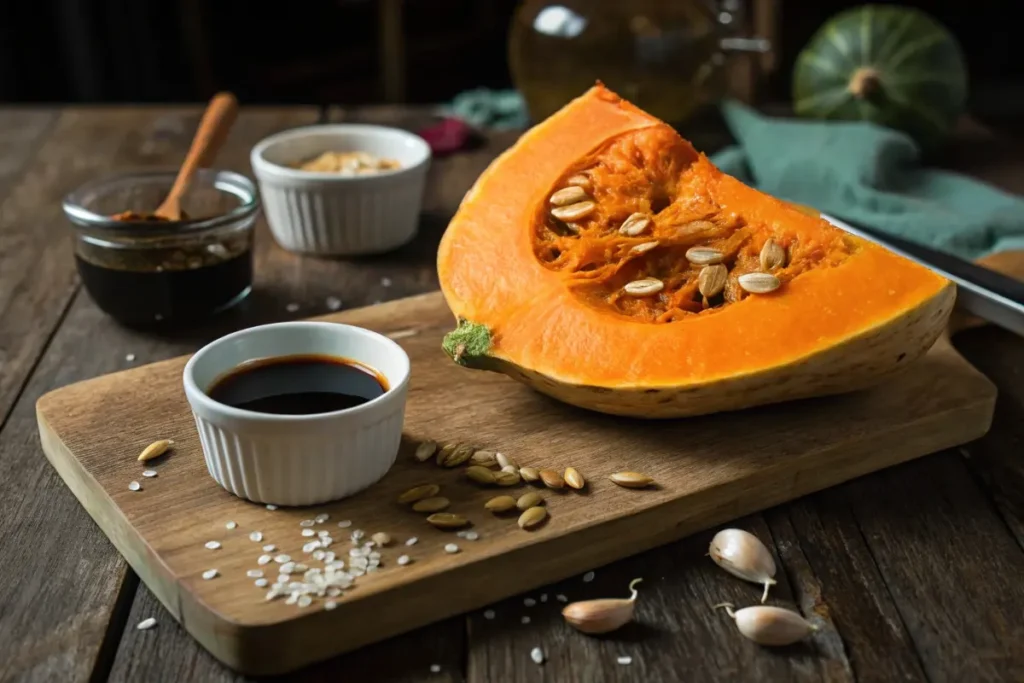
Step-by-Step Guide to Preparing Japanese Pumpkin
Now that we’ve explored what is Japanese pumpkin good for, let’s learn how to prepare it. Whether you want to try a kabocha squash baked whole or a simple stir-fry, these fundamental steps will ensure your squash is ready for cooking.
1. Selecting the Right Kabocha
- Appearance: Look for a squash with a deep green rind and a dry, corky stem.
- Weight: The squash should feel heavy for its size, indicating dense, moist flesh.
- Sound Check: Give it a gentle knock; a rich, hollow sound can indicate good internal structure.
2. Cleaning and Cutting
Caution: Kabocha’s rind can be tough, so use a sturdy knife and a non-slip cutting board.
- Wash and Dry: Rinse the squash under running water to remove any debris. Pat it dry.
- Halve and Scoop: Using a sharp knife, slice the squash in half from the top stem to bottom. Scoop out the seeds and stringy pulp using a spoon.
- Portioning: For roasting or simmering, cut it into wedges or chunks. If you prefer a kabocha squash recipe with a smooth puree, consider smaller cubes to speed up cooking.
3. Cooking Methods
a. Roasting (400°F/200°C):
- Drizzle wedges with olive oil, salt, and pepper (or soy sauce, if you like a Japanese twist).
- Roast on a baking sheet for about 25-35 minutes, depending on thickness.
b. Steaming or Boiling:
- Steaming: Place squash pieces in a steamer basket over simmering water for 15-20 minutes.
- Boiling: Submerge chunks in water or broth. Cook until fork-tender, roughly 15 minutes.
c. Stir-Frying:
- Slice or cube squash for faster cooking.
- Sauté in oil with garlic, onions, or ginger. Season with soy sauce, mirin, or miso for an asian k squash recipe flair.
4. Tips for Perfect Texture
- Avoid Overcooking: Kabocha can turn mushy if boiled or steamed too long. Check tenderness with a fork.
- Save the Skin: If you wonder, Do you eat the skin of kabocha squash? Yes! The skin becomes softer upon cooking and is typically edible.
- Balancing Sweetness: Pair the squash with salty or acidic components like soy sauce or vinegar to offset the sweetness.
5. Storage
- Fresh Kabocha: Can last up to a month in a cool, dark place.
- Cooked Squash: Refrigerate for 3-4 days in an airtight container.
If you’d like an example of integrating kabocha into a more complex dish, explore our Japanese Curry Recipe One Piece for a hearty stew that can easily accommodate roasted squash chunks.
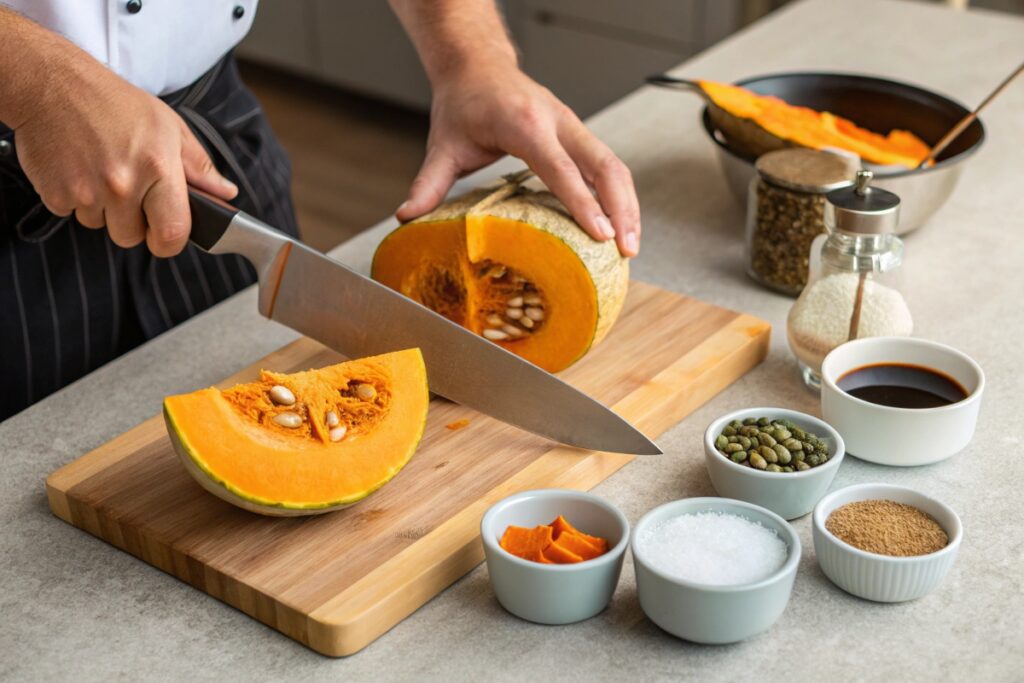
Four Must-Try Japanese Pumpkin Recipes
Ready to transform your kabocha into satisfying meals? Below are four variations of a japanese pumpkin recipe that showcase kabocha’s versatility and sweet-savory appeal.
1. Nimono-Style Kabocha (Simmered Pumpkin)
Overview:
A classic dish where kabocha is simmered in a dashi-based broth.
- Ingredients: Kabocha, dashi stock, soy sauce, mirin, sugar, a pinch of salt.
- Method:
- Cut kabocha into bite-sized wedges.
- Combine dashi, soy sauce, mirin, and sugar in a pot, bring to a gentle boil.
- Add squash, reduce heat, cover, and simmer until tender (about 15-20 minutes).
- Why It’s Great: The squash absorbs all the savory flavors, resulting in a melt-in-your-mouth texture.
2. Roasted Kabocha with Miso Glaze
Overview:
A sweet-savory dish ideal for a side or appetizer.
- Ingredients: Kabocha wedges, miso paste, honey (or sugar), soy sauce, sesame seeds.
- Method:
- Mix miso paste, soy sauce, and honey into a smooth marinade.
- Coat the wedges and roast at 400°F (200°C) for 25-30 minutes.
- Sprinkle sesame seeds for garnish.
- Why It’s Great: Roasted kabocha squash gains a caramelized exterior that highlights its natural sweetness.
3. Kabocha Tempura
Overview:
Lightly battered slices of squash, deep-fried to crisp perfection.
- Ingredients: Kabocha slices, tempura batter (flour, cold water, a pinch of baking powder), oil for frying.
- Method:
- Dip thin kabocha slices in tempura batter.
- Fry until golden brown.
- Serve with tempura dipping sauce or soy sauce.
- Why It’s Great: Crisp, airy coating contrasts beautifully with the sweet, soft interior.
4. Kabocha Soup (Creamy)
Overview:
A comforting puree that’s perfect for cooler weather.
- Ingredients: Kabocha chunks, onions, garlic, vegetable broth, milk or cream, salt, and pepper.
- Method:
- Sauté onions and garlic until soft.
- Add kabocha and broth; simmer until the squash is fork-tender.
- Puree in a blender, then stir in cream or milk.
- Why It’s Great: Silky smooth texture with a naturally sweet flavor.
For an additional creative twist, consider pairing these recipes with a hearty protein. Our Japanese Steak Recipe offers a savory counterpart to the sweet notes of kabocha, creating a well-rounded meal.
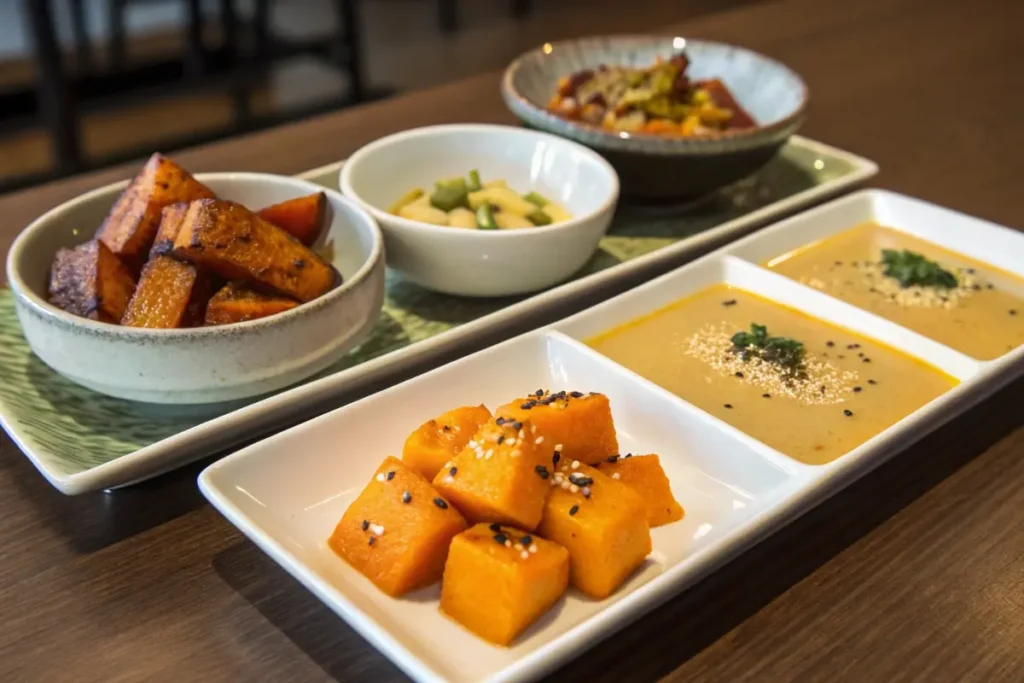
History/Context of Japanese Pumpkin
Although widely recognized today, kabocha has an intriguing history that sets it apart from other pumpkins. To understand its popularity in Japan, it’s helpful to delve into how kabocha arrived and evolved in local cuisine.
Early Origins
Kabocha is thought to have originated in parts of the Americas—specifically, it’s a type of winter squash. Trade routes during the Age of Exploration in the 16th century facilitated its introduction to various parts of Asia, including Japan. Over time, local farmers bred this squash to adapt to Japan’s climate, selecting for sweetness and a firm texture.
Historical Integration into Japanese Cuisine
In the Edo period (1603–1868), Japan’s isolationist policies limited imports but encouraged local agricultural experimentation. Kabocha flourished in certain regions due to its hardiness and long shelf life. Farmers discovered that once harvested, kabocha becomes sweeter over weeks of storage, making it valuable as a winter staple when fresh vegetables were scarce.
Gradually, dishes like kabocha no nimono emerged, reflecting a broader trend: the emphasis on balancing flavors—sweet, savory, salty, and occasionally bitter—within a single meal. This synergy perfectly suited the naturally sweet, slightly nutty nature of the Japanese pumpkin.
Modern Agriculture and Distribution
Japan’s modernization in the Meiji era (late 19th century) brought new farming techniques, enabling larger harvests of kabocha. Today, certain regions like Hokkaido are famed for producing premium kabocha with an even sweeter profile. With global trade routes, exporting Japanese pumpkin has become more common, allowing international cooks to try kabocha squash recipes worldwide.
Culinary Innovations
In contemporary kitchens, kabocha isn’t limited to traditional stews or side dishes:
- Fusion Cuisine: Chefs experiment with kabocha in pies, pastries, and even kabocha squash baked whole for a dramatic presentation.
- Health Food Movement: As more people discover the nutritional merits, kabocha has become a go-to ingredient in plant-based dishes, smoothies, and even baby food.
Legacy and Cultural Impact
Kabocha holds a sentimental place in Japanese cooking, often associated with comfort foods and seasonal festivities. It’s also a symbol of resourcefulness—once prized for its ability to last through winter months. If you’re intrigued by how other once-foreign produce adapted in Japan, check out our Japanese Corn Recipe for another example of a vegetable that’s been embraced and reinvented within local cuisine.

Practical Examples/Use Cases
Ever wonder how to fit a japanese pumpkin recipe into your busy lifestyle or special occasions? From quick weeknight dinners to impressive holiday gatherings, kabocha can adapt to various scenarios. Here are some creative ways to incorporate it:
1. Weeknight Meal Prep
- Scenario: You need a quick, healthy side dish on busy evenings.
- Approach: Roast kabocha wedges in advance, store them in an airtight container, and reheat as needed. Pair them with grilled fish, tofu, or even leftover chicken.
- Why It Works: Roasted kabocha retains its flavor and texture well, making it a convenient meal-prep staple.
2. Potluck or Buffet
- Scenario: You’re attending a gathering and need a unique dish.
- Approach: Prepare a large tray of miso-glazed roasted kabocha, or try a cold kabocha salad with spinach and sesame dressing. Garnish with sesame seeds or green onions.
- Why It Works: The sweetness of the squash complements a variety of flavors, and the dish can be served warm or at room temperature.
3. Seasonal Festivities
- Scenario: Hosting a holiday dinner or a casual get-together in the fall or winter.
- Approach: Create a comforting kabocha soup as an appetizer or side. Pair it with crusty bread and a light salad.
- Why It Works: The warm orange hue of kabocha soup adds a festive, seasonal touch to your table.
4. Kid-Friendly Meals
- Scenario: You’re trying to introduce more vegetables into your family’s diet.
- Approach: Mash cooked kabocha into a smooth puree, and incorporate it into macaroni and cheese, pancake batter, or even baked goods like muffins for a natural sweetener and nutrient boost.
- Why It Works: Kabocha’s mild, sweet flavor often appeals to children, and the bright orange color can be visually enticing.
5. Gourmet or Elevated Dining
- Scenario: You want to impress guests with a refined yet easy dish.
- Approach: Serve thinly sliced kabocha tempura with a dipping sauce made of soy, ginger, and grated daikon.
- Why It Works: Tempura embodies the elegance of Japanese cuisine, and kabocha’s sweetness pairs brilliantly with the tangy sauce.
For another multi-purpose vegetable that can easily star in both casual and fancy dishes, explore our Japanese Radish Recipe to see how versatile produce can enhance everyday meals.

FAQs About Japanese Pumpkin Recipe
Below are some common queries that people have regarding japanese pumpkin recipe. If you’re new to kabocha or seeking fresh ideas, these answers will help clarify the basics and beyond.
- What is the difference between pumpkin and Japanese pumpkin?
The main difference is that Japanese pumpkin (kabocha) is smaller, denser, and sweeter compared to typical Western pumpkins. Its rind is dark green and slightly bumpy, but still edible once cooked. - What is Japanese pumpkin good for?
Kabocha is highly versatile. It can be roasted, boiled, or stir-fried for dishes like soups, curries, and tempura. Its sweet, velvety flesh also makes it excellent for desserts or purees. - Is kabocha healthier than pumpkin?
Both are nutritious, but kabocha is known for a higher concentration of vitamins A and C, plus beta-carotene. It also tends to have fewer carbs per serving. This makes kabocha a go-to for people aiming to maximize nutrients in their meals. - Do you eat the skin of kabocha squash?
Yes, you can eat the skin. Kabocha’s rind softens upon cooking and contains additional fiber and nutrients. Just ensure you wash the squash thoroughly before preparing it.
– Can I bake kabocha squash whole?
Absolutely. Many kabocha squash baked whole recipes instruct you to pierce the rind in a few places for steam release. After baking, you can easily scoop out the flesh for soups or purees.
- How do I store leftover cooked kabocha?
Place leftovers in an airtight container and store in the refrigerator for up to 3-4 days. If you need long-term storage, freeze it in portioned containers—perfect for quick use in future recipes. - What are some creative dishes using kabocha?
Try it in sweet treats like muffins or puddings, or add mashed kabocha to pancake batter for a fall-inspired breakfast. For savory ideas, see our Japanese Chicken Fried Rice Recipe—you can add roasted kabocha cubes for extra flavor and color.
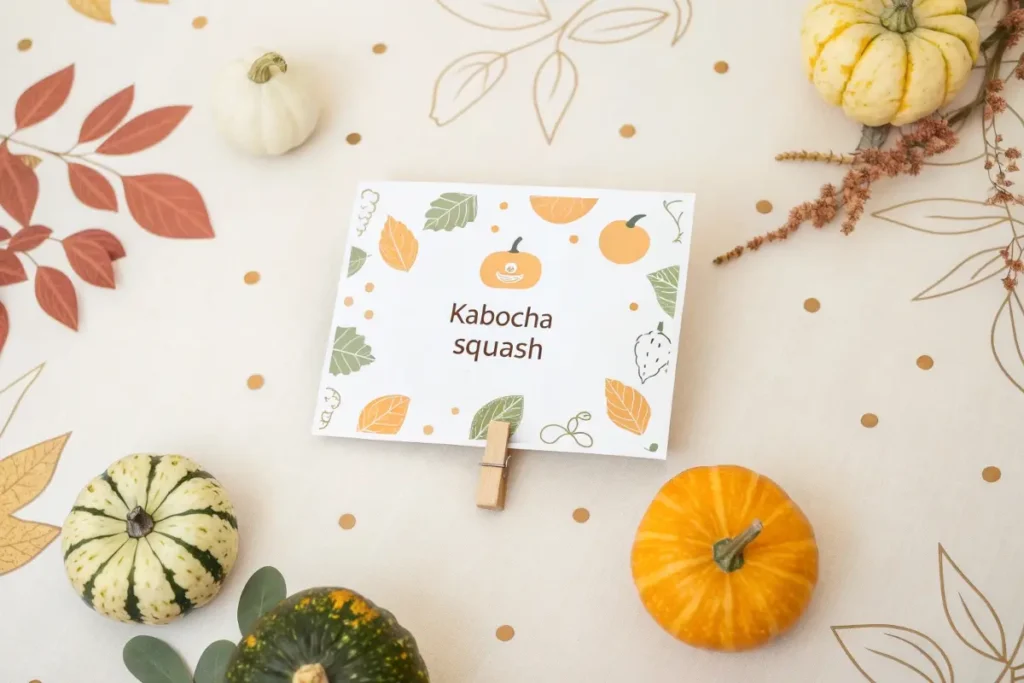
Conclusion
A japanese pumpkin recipe offers more than just a unique flavor; it’s a gateway to the richness and versatility of kabocha—a squash that can star in both everyday meals and special occasions. From simple roasting to intricate simmering, kabocha’s sweet notes and velvety texture elevate any dish, satisfying cravings for comforting yet nutritious fare.
Now that you’ve uncovered the best ways to prepare, cook, and serve kabocha, it’s time to bring these lessons to your own kitchen. Experiment with different sauces, from soy-based glazes to miso marinades, and discover how this small green squash can transform into heartwarming soups, delightful stir-fries, and crave-worthy tempura. For an even deeper dive into Japanese vegetables, browse our Japanese Vegan Recipes to see how to incorporate kabocha into diverse, plant-forward meals.
Armed with these insights, you’re all set to whip up a feast that highlights the charm of Japanese pumpkin. Whether you’re hosting dinner guests, fueling your family’s weekday dinners, or exploring new plant-based options, kabocha is sure to add a sweet and savory flair to your culinary adventures. Enjoy exploring the delicious possibilities!
